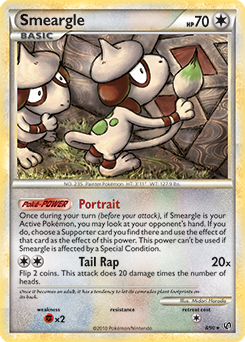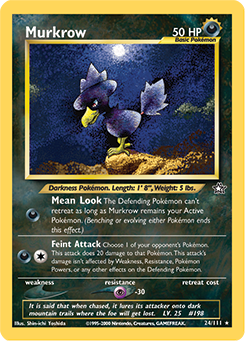The Pokémon Company is officially celebrating the 25th anniversary of Pokémon in full force. Read on below to learn more:
The 25th celebration continues with our Pokémon TCG experts weighing-in on this memorable region.
Our Pokémon TCG historians jumped at the chance to write about Johto in this retrospective—part of our yearlong 25th celebration. The Johto region has actually been featured twice in the long history of the Pokémon TCG; once in the early 2000s and then again nearly a decade later with the launch of the Pokémon HeartGold and Pokémon SoulSilver video games.
So, this month, fans can read about our Pokémon TCG superstars’ favorite cards from across two special eras of the game. Both feature incredible, memorable, and important cards. See which ones stood tallest in their memories!
Tord Reklev
Three-Time International Champion
 Smeargle from the HS—Undaunted expansion is truly one of the most iconic support Pokémon in my book. Its Portrait Poké-Power allowed the player to look at their opponent’s hand and use the effect of a Supporter card if they found one there. More importantly, this did not count as playing a Supporter card for the turn, which meant you could still play another Supporter card if you hadn’t already done that. Another interesting note is that Portrait couldn’t be cancelled after looking at the opposing hand—if there were Supporter cards there, one must be used. This could sometimes lead to hilarious situations where the only Supporter card in a player’s hand was a Professor Juniper, forcing the player using Portrait to discard their own large hand full of valuable resources.
Smeargle from the HS—Undaunted expansion is truly one of the most iconic support Pokémon in my book. Its Portrait Poké-Power allowed the player to look at their opponent’s hand and use the effect of a Supporter card if they found one there. More importantly, this did not count as playing a Supporter card for the turn, which meant you could still play another Supporter card if you hadn’t already done that. Another interesting note is that Portrait couldn’t be cancelled after looking at the opposing hand—if there were Supporter cards there, one must be used. This could sometimes lead to hilarious situations where the only Supporter card in a player’s hand was a Professor Juniper, forcing the player using Portrait to discard their own large hand full of valuable resources.
Smeargle’s existence alone impacted how decks were built, as constantly having Supporter cards in hand for the opponent to take advantage of could be a liability. Random Receiver later became a popular Item card to have saved up in hand, as it usually guaranteed a Supporter card for next turn while also denying Portrait from finding a target.
I also think it’s fitting that this Poké-Power is given to Smeargle, the Painter Pokémon. It can draw “portraits” of the beloved Supporter cards to copy their effects, which is just excellent card design.
 Anyone who has seen me at a real-life Pokémon event will not have a hard time guessing which Pokémon is my favorite. I always bring a Celebi playmat, coin, and plush mascot. Celebi has been my favorite Pokémon ever since I was a young child—and that hasn’t changed.
Anyone who has seen me at a real-life Pokémon event will not have a hard time guessing which Pokémon is my favorite. I always bring a Celebi playmat, coin, and plush mascot. Celebi has been my favorite Pokémon ever since I was a young child—and that hasn’t changed.
Shiny Pokémon were first introduced in the Johto era of the video games—Pokémon Gold, Pokémon Silver, and Pokémon Crystal—and were immediately popular, of course. The first time this concept was featured in the Pokémon TCG was in the 2001 Neo Revelation set with Shining Pokémon—specifically Shining Magikarp and Shining Gyarados. Shining Pokémon were also memorable from a gameplay perspective, as you could only have one in your deck—for the first-time, cards were restricted by more than the typical rule of four.
Shining Celebi (Neo Destiny, 106/105) came out in 2002 and is one of my favorite cards of all time. This is the first time my favorite Pokémon got that exclusive Shining version, and it looks stunning. The colors and pose on this card are beautiful, and I treasure it highly. It’s kept in a special binder, which is dedicated to all the different prints of Celebi cards that have been released. I was also gifted a copy of this card from an old friend a few years ago as a birthday present, which makes it even more special to me.
Jason Klaczynski
Three-Time Pokémon TCG World Champion
 It may be hard to believe a Pokémon with only 30 HP and no way to do damage could make a major mark on the game, but Cleffa (Neo Genesis, 20/111) did just that. It arguably saved the Pokémon TCG over 20 years ago.
It may be hard to believe a Pokémon with only 30 HP and no way to do damage could make a major mark on the game, but Cleffa (Neo Genesis, 20/111) did just that. It arguably saved the Pokémon TCG over 20 years ago.
Back in 2000, the game had been taken over by powerful Trainer cards that stripped away the opponent’s hand. Cards like Rocket’s Sneak Attack (Team Rocket, 16/82) and The Rocket’s Trap (Gym Heroes, 19/132) were combined to leave an unlucky opponent holding as few as zero cards—often before they even got to take a turn! With no useful cards in their hand, these players had two options: pull a miracle top deck or face a quick loss. The latter was the more common result, which left players frustrated.
But just as disheartened players were getting ready to stow away their Pokémon cards, the Neo Genesis set debuted, unveiling Cleffa to the world. Now, players who had their hand stripped away could recover a fresh new one of 7 cards, all for a single Energy! On top of that, Cleffa had a built-in defense: the new Baby Rule, which forced opponents to land a successful coin flip to attack it.
Players scrambled to trade for four Cleffa at their local Pokémon Leagues, hoping to give their decks the best chance possible of starting with it. In the process, the game’s strategic back-and-forth was reborn, as players were constantly drawing new hands and finding new options each turn to progress their board.
 What is the best attack in the history of the game? I’d say Murkrow’s (Neo Genesis, 24/111) Mean Look, which permanently prevented an Active Pokémon from retreating. Working in perfect synergy, Murkrow’s Feint Attack allowed you to attack the opponent’s Bench while the Active Pokémon was trapped.
What is the best attack in the history of the game? I’d say Murkrow’s (Neo Genesis, 24/111) Mean Look, which permanently prevented an Active Pokémon from retreating. Working in perfect synergy, Murkrow’s Feint Attack allowed you to attack the opponent’s Bench while the Active Pokémon was trapped.
There were a variety of ways to use Murkrow’s Mean Look to ruin an opponent’s day. You could target a Psychic-type Pokémon, since Murkrow resisted it. You could combine it with Energy Removal (Base Set, 92/102) and Super Energy Removal (Base Set, 79/102), stranding a Pokémon you had stripped of the Energy it needed to attack. You could isolate a Pokémon that only dealt a small amount of damage, then use healing cards like Gold Berry (Neo Genesis, 93/111) to keep Murkrow healthy and delivering Feint Attacks.
The opponent’s best ways to escape Mean Look were Trainer cards such as Switch (Base Set, 95/102) and Scoop Up (Base Set, 78/102), but clever deck builders paired Murkrow with Trainer-denying Pokémon like Slowking (Neo Genesis, 14/111) and Dark Vileplume (Team Rocket, 13/182) to block the opponent from using these.
The end result was that any player, no matter how large their Prize card lead, could have the game stolen from them by a single Mean Look.
Ross Cawthon
17 World Championships Appearances, Two-Time Worlds Runner-Up
 Neo Genesis was one of the most important Pokémon TCG expansions. In addition to introducing the newly discovered Johto Pokémon, it introduced two new types, Metal and Darkness, along with Metal (Neo Genesis, 19/111) and Darkness (Neo Genesis, 104/111) Energy, which had special effects. The first great Metal-type Pokémon was Steelix (Neo Genesis, 15/111); while Steelix doesn’t have any particularly eye-popping numbers, the defensive power of Metal Energy made it a top Pokémon of the era.
Neo Genesis was one of the most important Pokémon TCG expansions. In addition to introducing the newly discovered Johto Pokémon, it introduced two new types, Metal and Darkness, along with Metal (Neo Genesis, 19/111) and Darkness (Neo Genesis, 104/111) Energy, which had special effects. The first great Metal-type Pokémon was Steelix (Neo Genesis, 15/111); while Steelix doesn’t have any particularly eye-popping numbers, the defensive power of Metal Energy made it a top Pokémon of the era.
At this time, Pokémon didn’t do as much damage as quickly as today’s cards do. Games would take more turns, which meant that getting three or even four Metal Energy on a single Steelix was very doable. Reducing 30 or 40 damage from every attack made it incredibly hard to take down a Steelix. Consider this: reducing 40 damage on a 110 HP Pokémon would be like reducing 120 damage on a 330 HP Pokémon VMAX today! Similarly, Gold Berry (Neo Genesis, 93/111) healing 40 damage for no cost was also a massive amount given the typical attack strengths and HPs of the Neo era. Between Metal Energy and Gold Berry, one Steelix could survive many turns, if not complete a whole game.
Feraligatr (Neo Genesis, 5/111) was the first true “combination” attacking deck to be successful. Most Pokémon follow the familiar pattern of “attach more Energy and do more damage.” However, Feraligatr’s Riptide attack didn’t do more damage for Energy in play, but rather for every Water Energy in the discard pile. Its Downpour Poké-Power played right into Riptide, discarding Water Energy from your hand. A drawback of Riptide was that it shuffled all of the Water Energy from your discard pile into your deck, making your next attack difficult.
Two cards combined well with Feraligatr. The first was (Gym Heroes, 126/132) Trash Exchange. On the surface, this seems like a silly card: shuffle your discard pile into your deck and then randomly discard the same number of cards from your deck. This could help you or hurt you. With Feraligatr though, you could play Trash Exchange after a Riptide. Since all your Water Energy were in the deck, it was likely many Water Energy would move from the deck to the discard pile. Later, Feraligatr was paired with Parasect (Neo Revelation, 35/64). Parasect’s Allergic Pollen Poké-Power would prevent the Water Energy from being shuffled into the deck, meaning you only had to discard a lot of Water Energy once.
The Pokémon TCG has seen many unique attacks, ones that did more damage based on damage on your Pokémon, specific combinations of Pokémon in play, cards in your discard pile, cards in your hand, etc. Feraligatr’s Riptide was the first of these powerful unorthodox attacks to dominate the game.
Michael Pramawat
Europe International Champion, Worlds Runner-Up
 Do you even know Donphan Prime? This extraordinary Pokémon is a giant stat stick. Everything about it shows the bump in power level of the HeartGold & SoulSilver era. First off, this Stage 1 Pokémon had 120 HP, an amount previously only reached by Stage 2 Pokémon. If that didn’t make it tanky enough, its Exoskeleton Poké-Body made it even more difficult to take down. Earthquake could one-hit KO Luxray GL LV.X, and Heavy Impact itself was a very good attack. This card was great from the day it was released, and it had solid matchups across the board.
Do you even know Donphan Prime? This extraordinary Pokémon is a giant stat stick. Everything about it shows the bump in power level of the HeartGold & SoulSilver era. First off, this Stage 1 Pokémon had 120 HP, an amount previously only reached by Stage 2 Pokémon. If that didn’t make it tanky enough, its Exoskeleton Poké-Body made it even more difficult to take down. Earthquake could one-hit KO Luxray GL LV.X, and Heavy Impact itself was a very good attack. This card was great from the day it was released, and it had solid matchups across the board.
However, the main reason I love Donphan Prime isn’t for its power when it was legal in Standard, but for how great this card is in a cube draft. This is one of the few cards from the era that, on a pure stats level, can hold its ground vs. current non-rule box cards. If I’m drafting with a group of friends and Donphan makes it to me, I instantly want to pick it because of how great this card has stood the test of time. The fact that the four Energy Retreat Cost made it searchable with Heavy Ball is another interaction that makes this card interesting in cube drafts.
 I love this card for many reasons. The first reason is that shuffle draw was rare at the time when Neo Genesis was released, and not being forced to discard your hand to draw new cards was refreshing. It was Pokémon’s first attempt to balance Professor Oak, which is, arguably, the best card ever printed. It was a clear sign that Pokémon was trying to balance the game, and they were willing to try new things to keep the game fun and fresh.
I love this card for many reasons. The first reason is that shuffle draw was rare at the time when Neo Genesis was released, and not being forced to discard your hand to draw new cards was refreshing. It was Pokémon’s first attempt to balance Professor Oak, which is, arguably, the best card ever printed. It was a clear sign that Pokémon was trying to balance the game, and they were willing to try new things to keep the game fun and fresh.
Another reason why this card is interesting is because it was the prototype of Supporter cards. Professor Elm had the drawback of not being able to play Trainer cards after you had played this card. This drawback was a bit too harsh, so they eventually landed on the Supporter card type that you can only play once per turn. It’s cool to see how the Pokémon TCG transitioned throughout history, and Professor Elm is a middle ground of that transition. The joy Professor Elm has when holding up Cyndaquil is the same joy I get when holding this card in my hand.
Mike Martin
20-year Pokémon TCG Professor
 I’m always interested when the Pokémon TCG gives players a new way to win games. Usually, games end by Pokémon being Knocked Out and Prizes being taken, and occasionally by a player not having any cards left in their deck. But the HeartGold & SoulSilver Series gave us Lost World and the best way to exploit it, Gengar Prime. First though, note that “Prime” is not part of Gengar‘s name, it just describes the group of powerful Pokémon released at that time that were exploding out of their picture box. They even caused a bit of confusion for some players. They thought “Prime” was part of their card names (even though “Prime” is written nowhere on the cards) or that you got two Prizes for Knocking them Out since they looked so special. But no, they were just regular Pokémon.
I’m always interested when the Pokémon TCG gives players a new way to win games. Usually, games end by Pokémon being Knocked Out and Prizes being taken, and occasionally by a player not having any cards left in their deck. But the HeartGold & SoulSilver Series gave us Lost World and the best way to exploit it, Gengar Prime. First though, note that “Prime” is not part of Gengar‘s name, it just describes the group of powerful Pokémon released at that time that were exploding out of their picture box. They even caused a bit of confusion for some players. They thought “Prime” was part of their card names (even though “Prime” is written nowhere on the cards) or that you got two Prizes for Knocking them Out since they looked so special. But no, they were just regular Pokémon.
Along with Pokémon Primes, the Lost Zone was also introduced to the game at this time. It’s a game location where cards were forever lost, unable to be brought back into the game, unlike cards that went to the discard pile. While this was inconvenient, it wasn’t game breaking. But then Lost World was released, which allowed you to declare that you won the game during your turn if your opponent had 6 or more Pokémon in the Lost Zone. There were a number of ways that a card could wind up in Lost Zone, but most of them were voluntary and involved your own cards. Gengar Prime, on the other hand, gave you lots of ways to put multiple copies of your opponent’s Pokémon in there. You could strip them out of their hand using its Hurl into Darkness attack or Knock Out opposing Pokémon using its Cursed Drop attack, which would send its victims to the Lost Zone thanks to the Catastrophe Poké-Body. It was a pretty cool mechanism that I hope we see again.
 Sneasel (Neo Genesis, 25/111) was the first Pokémon card that was banned from competitive play for balance reasons. Before it was banned, it was found in almost every deck at the top cut of tournaments. Looking at the card now, it’s hard to believe when you compare it to the vast damage that Pokémon can do now, that a 60 HP Pokémon that looks like it averaged 60 damage could dominate a format so much. In fact, that card was reprinted with minor variations multiple times over the years without any of them being used much competitively. Take a look at these: Sneasel-EX, Sneasel, and Sneasel. Aside from some minor changes to their stats, they are all very close to the original banned card. But not only were they not dominating, they weren’t even worth playing. What makes the difference?
Sneasel (Neo Genesis, 25/111) was the first Pokémon card that was banned from competitive play for balance reasons. Before it was banned, it was found in almost every deck at the top cut of tournaments. Looking at the card now, it’s hard to believe when you compare it to the vast damage that Pokémon can do now, that a 60 HP Pokémon that looks like it averaged 60 damage could dominate a format so much. In fact, that card was reprinted with minor variations multiple times over the years without any of them being used much competitively. Take a look at these: Sneasel-EX, Sneasel, and Sneasel. Aside from some minor changes to their stats, they are all very close to the original banned card. But not only were they not dominating, they weren’t even worth playing. What makes the difference?
Well, there are a few reasons. The original had a free Retreat Cost—never underestimate the value of being able to run away for no cost, especially when that cost would be a precious Darkness Energy. This Special Energy card, also introduced in the Neo Genesis set, gave a bonus of 10 damage to attacks. What’s more, this bonus stacked with each additional Energy attached. This made it enough to take out the most common attackers found in decks in one hit. Finally, since players ran it with four Rainbow Energy (Aquapolis, 144/147) to get past the limitation of four copies of the Darkness Special Energy, it could fit in just about any deck using any Energy type. The other big reason the later reprints weren’t able to dominate was due to the increased HP of competing attacking Pokémon. Doing only 70 or 80 damage just didn’t cut it anymore.
The Pokémon TCG community would not be the same without these five contributors to the game, and we appreciate their valuable insights. Be sure to check back throughout the year to see more of their reflections on their favorite cards from the long history of the Pokémon TCG.
About the Contributors

Tord Reklev
Tord Reklev is a contributing writer for Pokemon.com. He is a longtime player from Norway, playing the game since he was 6 years old. He is notable for being the only Masters Division player to win the North America, Europe, and Oceania Internationals, and he recently made Top 4 at the World Championships. Outside of the game, he is a student and enjoys playing tennis. You can find him at most big events, and can follow him on Twitter at @TordReklev.

Jason Klaczynski
Jason Klaczynski is a three-time Masters Division World Champion (2006, 2008, 2013) and the 2015 US National Champion. Jason began playing the Pokémon TCG during the initial Pokémon craze of 1999 and played competitively from that point through 2017. Since then, Jason has focused on re-exploring and writing about the game’s earliest formats, which he regularly plays with friends.

Ross Cawthon
Ross Cawthon is a longtime player, starting to play tournaments in 2000. He is the only player to compete in all 17 Pokémon TCG World Championships, finishing as a finalist in 2005 and 2011, and a semi-finalist in 2016. He is known for creating many new “rogue” decks over the years. Ross has a Ph.D. in astrophysics and studies dark energy (not to be confused with Darkness Energy cards).

Michael Pramawat
Michael Pramawat is a seven-time Regional Champion and International Champion. He has competed at the highest level and was almost World Champion, finishing second in 2010. Michael is a master of the Pokémon TCG and continues to play with the goal of being the very best, like no one ever was. You can follow him on twitter at @michaelpramawat.

Michael Martin
Michael Martin, AKA “PokePop,” hasn’t won a single tournament. He has been judging and running Pokémon TCG events since 2000 and has been invited to judge at every single Pokémon World Championships. He also helps maintain the Pokémon TCG Compendium, where all official game rulings for Organized Play are collected. ‘Pop misses seeing all the players and other Professors in person and can’t wait for live events to resume.
Source: Pokemon.com
Source:Pokémon





